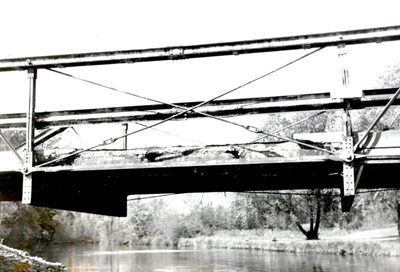
October 24, 2013
Inadequate, Structurally Deficient Brides: A National Problem: Then and Now

By: Joseph S. Jones, Commissioner of the West Virginia Department of Highways
Published in the AASHTO Quarterly, October 1977
The following piece was published in the AASHTO Quarterly by West Virginia Department of Highways Commissioner Joseph Jones in October 1977. Jones discusses the deteriorating state of the nation’s bridges and his fear that the problem would continue to go unaddressed. While state transportation departments have been tackling failing bridges for decades, they are still grappling with how to keep up with those bridges that are deteriorating, sometimes by rates faster than DOTs can repair or replace them. Check out the story below.
The following piece was published in the AASHTO Quarterly by West Virginia Department of Highways Commissioner Joseph Jones in October 1977. Jones discusses the deteriorating state of the nation’s bridges and his fear that the problem would continue to go unaddressed. While state transportation departments have been tackling failing bridges for decades, they are still grappling with how to keep up with those bridges that are deteriorating, sometimes by rates faster than DOTs can repair or replace them. Check out the story below.
Ours is a nation which relies almost totally upon its network of highways, roads and streets for daily transportation. Transportation of goods and services, national defense resources and daily commuting to and from our place of work or business is totally dependent upon the highway system. And when we aren’t moving about on this system in the pursuit of commerce, we are utilizing the system for recreational activities. As a result of the system which we have developed, our citizens have a freedom of mobility unequalled anywhere in the world.
Yet this transportation system is deteriorating faster than we are constructing and maintaining it—some estimates indicate 50 percent faster. Nowhere is this problem more acute than in the case of bridges. This, then, has to be the most critical transportation problem government faces today, at all levels from local to national.
It is presently estimated that there are approximately 564,000 bridges in the United States on various state and county highway systems, approximately 20 percent of which are either structurally deficient or functionally obsolete as defined by the Federal Highway Administration and in need of replacement or reconstruction. Approximately 60 percent of all deficient bridges are located on “off system” routes.
Thus the problem cannot be totally approached at any one level of government. It will require coordinated effort at all levels.
But why, one may ask, have we reached a point where the problem has become so acute? The majority of our system has evolved during the last 60 years. Many structures have only been in existence from 30 to 60 years. If one assumes they were structurally adequate at the time of construction, then how can so many become so deficient so quickly?
The most direct answer to this question is neglect in maintaining bridges and the absence of adequate programs to replace bridges on a systematic basis as they become obsolete from the standpoint of load-carrying capacity and geometry.
The reason for inadequate maintenance and systematic replacement of bridges has primarily been insufficient funds directed to that area of the highway program. Although this has been due to funds generally insufficient to keep the upgrading of the total highway systems apace with the growth of traffic, it is also a problem of past application of available funds. This is not an implication that state highway officials have been negligent in their use of available funds but an example of the very nature of the relationship of government and the public. Public input to government officials is very much prejudiced toward repairs, construction and maintenance of roadway surfaces rather than bridges. The public rarely raises a question concerning a bridge unless the roadway surface is in need of repair, a load limit has been imposed or the structure has been closed. Public officials and highway engineers are under constant pressure to expend available funds for work which most directly and demonstratively benefits the public, such as road construction, paving and repair. Generally speaking, bridges have taken a low priority in regard to available maintenance and construction funds. Thus, more than half a century of deterioration has resulted in a situation of emergency proportions.
The only solution to improving the critical problem of bridges throughout the country is a massive input of funds directed in a systematic manner toward replacement and reconstruction of bridges.
During the years following the collapse of the Silver Bridge in West Virginia, many states have implemented programs to provide more funds for replacement or improvement of bridges. In West Virginia, voters approved a $500 million bond issue, of which $120 million was for replacement of a number of the more critical bridges. This was only a small portion of the total funds needed to improve the state’s bridges. West Virginia just cannot generate the terrific magnitude of funds required to reduce the large backlog of structures already in need of replacement or reconstruction or to be added to that category in the next 10 or 20 years.
Most states, out of necessity for keeping highways open and maintaining the economy of the state, have diverted available bridge maintenance funds to repairing and strengthening bridges which should be replaced if funds were available. This severely hampers preventive maintenance activities and therefore further accelerates deterioration of bridges.
The absence of preventive maintenance and the heavy use of deicing chemicals have caused an unprecedented rate of bridge deterioration. Not only are we faced with a large backlog of critically deficient bridges but our presently good bridges are deteriorating at a rate faster than our ability to repair or replace them.
This leads us to the belief that there must be a significant increase in federal funds available for improvement of bridges, and that these funds must be extended to include “off system” bridges as well as those on the Federal Aid System. Such legislation is vital to our continued growth and development as a nation.












